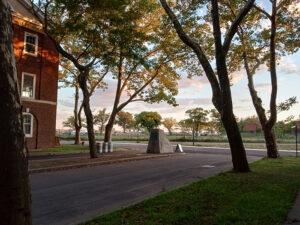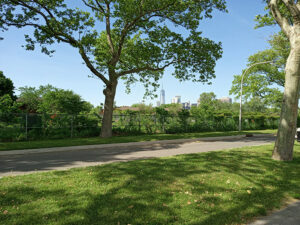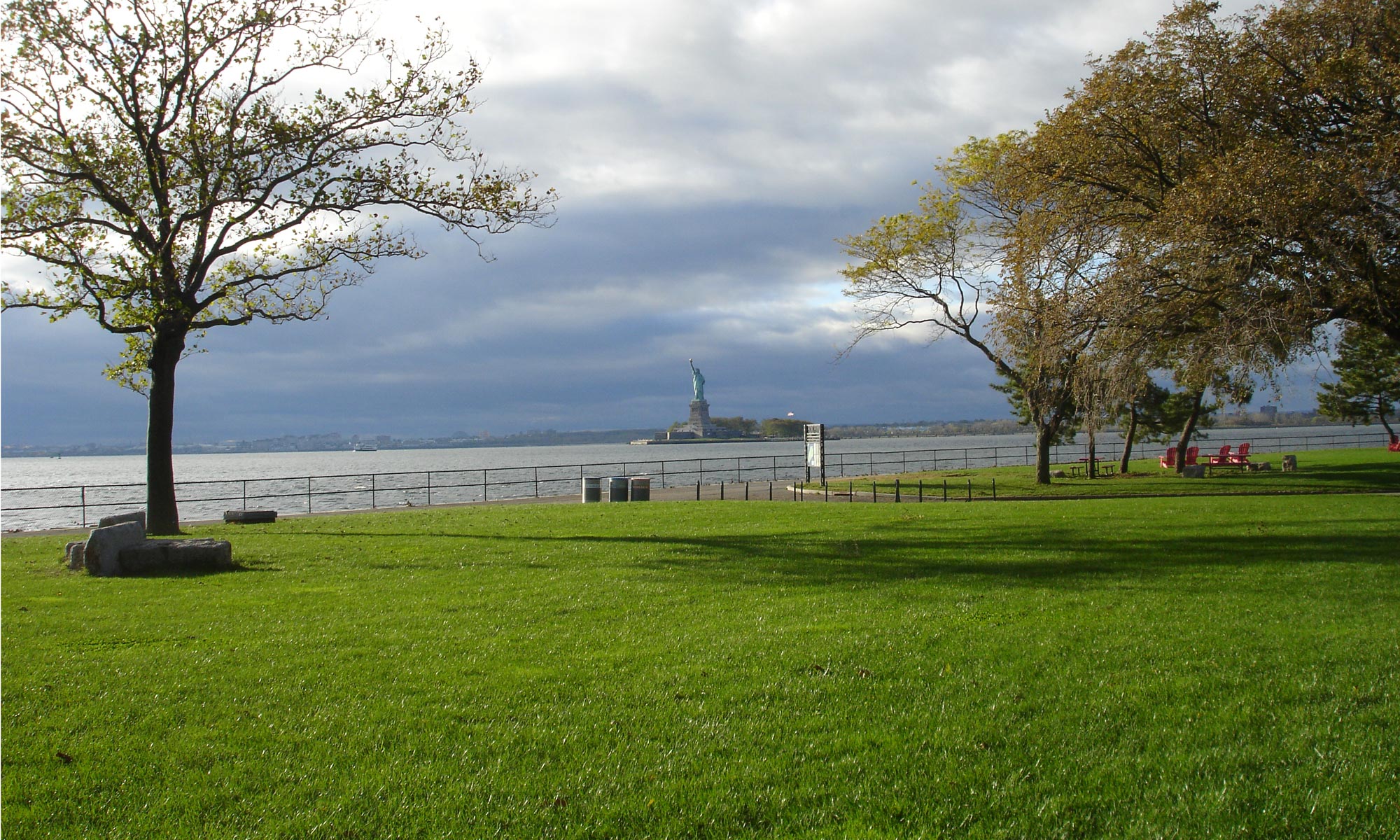Governors Island zoning lawsuit update and new 6 min video presentation
A Motion For Leave to Appeal for the lawsuit against the egregious 2021 upzoning on Governors Island has been filed with the New York State Court of Appeals pro se by Petitioner- Appellant M.A.G.I.C. co-founder Roger Manning.
Neither the December 2022 New York State Supreme Court decision nor the Appellate Division February 2024 decision against our lawsuit addressed our actual argument which is directed at the action, the City’s approval of the zoning, not the thing – the zoning text itself. It is arbitrary and capricious of the City to approve zoning that will allow and encourage violations of the restrictive covenants in the Governors Island Deed that the City is obligated to enforce, covenants that bind the City itself.
Appeal overview and excerpts below video.
This lawsuit is currently the general public’s only way to directly challenge the egregious 2021 rezoning that is gateway to undermining the vision of the 2003 Deed and 2010 Masterplan which serve to guide the evolution of Governors Island as a unique natural and built environment, a green urban refuge for people and wildlife – a public space meant for the enjoyment of all.
Christopher Marte, the New York City Council Member for Manhattan District 1, was joined by numerous others in filing an amicus brief in support of the lawsuit which is relevant regarding city and statewide land use, efforts to protect public land, public standing considerations, and municipal contractual accountability.
Amongst other things the 2021 GI upzoning:
(a) Invites a multitude of Deed violations including prohibited private residential development.
(b) Would allow high-rise (225ft plus) high density (3,775,000 million sq ft across 34 acres) development on an island of completely low-rise structures (historic and other), vast open green spaces, countless mature trees, abundant wildlife, and a major route for migratory birds.
(c) Imposes parking for 200 vehicles on a traffic free island.
(d) Would allow displacement of a thriving urban farm, a citywide compost center, and other environmental projects.
(e) Would box in and cast shadows on the “open space subarea” (unprotected south island park), historic district, and Urban Assembly New York Harbor School with high-rise development.
(f) Would allow building heights rising to 3 times the height of and blocking views from the south island’s high point, 70 ft “Outlook Hill.”
(g) Would allow building on 20% of the “open space subarea” (unprotected south island park).
(h) Would allow manufacturing activity prohibited by the Deed
 The 2021 upzoning is blatantly in conflict with the G.I. Deed’s requirement that 40 acres be dedicated as parkland in perpetuity in mapping the the supposed parkland with C4-1 high rise commercial zoning.
The 2021 upzoning is blatantly in conflict with the G.I. Deed’s requirement that 40 acres be dedicated as parkland in perpetuity in mapping the the supposed parkland with C4-1 high rise commercial zoning.
As Manhattan Community Board 1 stated in its December 2020 resolution, the City’s plan is nearly three times larger than the public’s original understanding of what it would be, “and the drastic increase in scale of development is unacceptable.” When the Community Board sought evidence to support the City’s suggestion that the proposed amount of development space was necessary to achieve their goals of making Governors Island financially self-sufficient and establishing a world-class academic and scientific Climate Solutions Center, the Trust did not provide it.
The zoning essentially, “amounts to commercial exploitation of a public asset.”
– Layla Law-Gisiko, President of the City Club of New York.
Neither the courts nor the City’s lawyers have challenged M.A.G.I.C.’s key assertion that the uses and allowances of the 2021 zoning would violate the spirit of the 2003 Deed which was intended to “ensure the protection and preservation of the natural, cultural and historic qualities of Governors Island,” so that the Island would serve as “an educational and civic resource of special historic character and as a recreational and open space resource” – not “the site of a sweeping economic development project” as the De Blasio administration took it upon themselves to later decide. Council Member Marte, Community Board 1, NYS Assemblymember Deborah Glick, scores of organizations on M.A.G.I.C.’s community sign-on, and the vast majority of general public hearing testimony share this view.
Governors Island
 Governors Island is NYC’s incredibly unique 172 acre “Country Place in the City” in the center of New York harbor. It provides a safe, one-of-a-kind pastoral experience for NYC families and their children – an essential natural public health and well-being resource for all New Yorkers – particularly those of lower and middle income who lack the resources to spend time away from the city.
Governors Island is NYC’s incredibly unique 172 acre “Country Place in the City” in the center of New York harbor. It provides a safe, one-of-a-kind pastoral experience for NYC families and their children – an essential natural public health and well-being resource for all New Yorkers – particularly those of lower and middle income who lack the resources to spend time away from the city.
This former military base is home to a national monument, a historic district, a high school, expansive (currently unprotected) parkland, and space for environmental, educational, and arts projects, as well as fitness and recreation.
– The Future of Governors Island? – M.A.G.I.C. 6 minute video presentation HERE
– Feb 2024 Press conference with City Council Member Christopher Marte HERE
– “Trees Not Towers” Legal Fund HERE
Motion For Leave to Appeal excerpts below.
The Lawsuit
Index No. 158809/21 Case No. 2023-03112
In the Matter of ROGER MANNING, Petitioner-Appellant,
-against-
CITY COUNCIL OF THE CITY OF NEW YORK et al., Respondents
Document lists:
– Appellate Division – 1st Dept (first appeal):
https://iapps.courts.state.ny.us/nyscef/DocumentList?docketId=NCyMWDFj7Y2ENQ2eXDBfPw==&display=all
– New York County Supreme Court (first court)
https://iapps.courts.state.ny.us/nyscef/DocumentList?docketId=i4G24KyDvnwmGVIHOtbJYg==&display=all
From the May 2024 pro se Motion For Leave To Appeal To The NYS Court Of Appeals:
Part1: QUESTIONS PRESENTED
(The legal issues you addressed in the courts below that you desire this Court to review. )
I. RESPONDENTS’ UPZONING THAT ENABLES VIOLATIONS OF RESTRICTIONS THAT BIND THEM IS ARBITRARY AND CAPRICIOUS Pet. Br. at 26
The Appellate Division – 1st Dept’s substantive based ruling, “petitioner’s claim — that the Zoning Resolution and map amendments were arbitrary and capricious because they violated the restrictive covenants — necessarily fails” (Decision and Order at 3) does not address petitioner’s procedural argument, which is that respondent’s decision to approve a zoning Resolution and map amendments that are inconsistent with, and will enable, and indeed invite, violations of Deed restrictions to which the respondents are bound is arbitrary and capricious. Neither the Supreme Court nor the Appellate Division addressed this fact. None of the cases relied on by the City are ones in which the City is bound by the covenant.
The City’s opposition is firmly focused on attacking an argument that Petitioner never made—that “zoning and contractual covenants [must] be identical,” City Br. at 2—while failing to address the argument that Petitioner does make: that a rezoning that breaches a municipality’s contractual obligation is arbitrary and capricious. Matter of Wa-Wa-Yanda v. Dickerson, 18 A.D.2d 251 (2d Dep’t 1963). Petitioner’s A.D. Reply Br. (“Pet. Rep. Br.”) at 1.
It is a bedrock principle of administrative law that an agency is bound to follow its own rules, and that a failure to do so makes the agency’s decision arbitrary and capricious. See, e.g., Vukel v NY Water & Sewer Mains, Inc., 94 N.Y.2d 494, 496 (2000); Partman v. N.Y.S. Div. of Hous. & Community Renewal, 179 A.D.3d 466, 467 (1st Dep’t 2020); Dobbins v. State of N.Y.-Unified Court System, 189 A.D.3d 1397 (2d Dep’t 2020). Petitioner’s A.D. Br. (“Pet. Br.”) at 26
The entire thrust of the City’s argument below, which was adopted by the Supreme Court, is that it intends to abide by the Deed Restrictions, and the zoning is irrelevant to those Restrictions. But if the City intends to abide by the Restrictions, and indeed to enforce them, it makes no sense—and it is arbitrary and capricious— to enact zoning that will enable, and indeed invite, violations of those same Restrictions. It makes no sense and is arbitrary and capricious for the Trust to sponsor and urge upon the Community Board, the City Planning Commission, and the City Council a rezoning that allows as-of-right uses and construction that would violate those Deed Restrictions. And it makes no sense, and is arbitrary and capricious, for the City Council to knowingly, deliberately, enact zoning that enables, with no further discretionary review, construction and uses that would then have to be fought in a lawsuit initiated by the City’s own alter ego, the Trust. Pet. Br. at 29
The suggestion that the Trust can be trusted to enforce the Deed Restrictions defies logic. It is the Trust, after all, that proposed the amended zoning and shepherded it through the approval process, and that now takes the position, contrary to the plain text of the zoning and the Deed, that the two are consistent with one another. Having proposed the amended zoning, and having taken the position that the zoning is consistent with the Restrictions, the Trust will not block those same uses and construction on the ground that they violate the Deed Restrictions. Pet. Reply Br. at 14
But not only is the City’s massive upzoning in conflict with the Deed Restrictions. The City has never produced even a smidgen of evidence to show that the goals of making Governors Island financially self-sufficient and establishing a world-class academic and scientific Climate Solutions Center require this much density, this much height, open spaces that are not protected as dedicated parkland, and industry and manufacturing everywhere. When the Community Board sought evidence to support the City’s suggestion that the proposed amount of development space was necessary to achieve their goals, Respondents refused to provide it. R636. Pet. Reply Br. at 33
II. RESPONDENTS’ UPZONING ENABLES AND ENCOURAGES VIOLATION OF SPECIFIC GOALS AND RESTRICTIONS IN THE DEED
The approved zoning is inconsistent with both the letter and the intent of the Deed Restrictions. The primary goal of the Deed is “to ensure the protection and preservation of the natural, cultural and historic qualities of Governors Island.” The other goals are, in order, to “guarantee public access to this magnificent island, promote the quality of public education, and enhance the ability of the public to enjoy Governors Island and the surrounding waterways, thereby increasing the quality of life in the surrounding community, the City, the State and the United States.” R92.
The City goals, which are built in to its zoning amendments, are at odds with the vision of a unique island where one can “leave the city without leaving,” a place of “views, wind, tides, currents, horizon, escape,” “vast water, big sky,” sharply different from Manhattan, described in the Master Plan. R2744, R2758, R2752. With its out-of-scale tall buildings and density, the adopted zoning negates the Deed’s goal of “preserv[ing] and enhance[ing] these views [of the harbor], from all around the edge of the island and from its interior.” Pet. Br. at 31
III. THE CITY’S CONTENTION THAT THE UPZONING “DOES NOT CONFLICT WITH THE RESTRICTIVE COVENANTS” IS ABSURD
A. The Amended Zoning’s Allowance of Industrial and Manufacturing Uses Throughout the Southern Subdistrict Breaches the Covenant’s Absolute Prohibition of Such Uses. Pet. Reply Br. at 5
B. The Amended Zoning’s Allowance of All Residential Uses Breaches the Covenant’s Prohibition of All But Specified Residential Uses
The City could have specified additional residential uses consistent with the Deed. It did not.
Instead, in breach of the Deed’s prohibition on all but specified residential uses, it chose to allow all residential uses, without limitation. This is yet another reason why the amended zoning must be annulled. Pet. Reply Br. at 7
C. The Amended Zoning Is Blatantly in Conflict With the Deed’s Requirement that 40 Acres Be Dedicated as Parkland in Perpetuity
Petitioner’s Brief described the ways in which the amended zoning is in conflict with the Deed’s requirement that 40 acres “shall be dedicated and used as [public parkland] in perpetuity.” Deed § 2.3 (a):
• failing to dedicate any acreage as parkland and re-mapping the entirety of the South Island, including all of the supposed parkland, with C4-1 commercial zoning;
• allowing “private parks,” without limitation” (ZR 134-112(a));
• allowing “buildings or other structures containing permitted uses, up to a
height of … 25 feet,” equivalent to 2.5 stories, occupying as much as 20
percent, or 8.6 acres, of the Open Space Subarea (ZR 134-24(b)(5));
• allowing cellars underneath the entirety of the Open Space Subarea, to be
used for any “use otherwise permitted in the Southern Subdistrict,” including large-scale commercial, manufacturing and industrial uses (ZR 134-112(a)). Pet. Reply Br. at 9
IV. THE APPELLATE DIVISION ERRED IN STATING THAT “PETITIONER PROFFERS NO EVIDENCE THAT THE TRUST PLANS TO ALIENATE OR DEVELOP PARKLAND FOR NONPARK PURPOSES;”
The Amended Zoning is explicitly describes plans to alienate or develop parkland for nonpark purposes. SEE III(C) above.
V. RESPONDENTS’ UPZONING VIOLATES THE PUBLIC TRUST DOCTRINE
Respondents’ failure to dedicate parkland in conjunction with their rezoning was arbitrary and capricious.
In the alternative and/or additionally, Respondents’ upzoning should be invalidated as violative of the public trust doctrine. Given that Respondents have stated in sworn testimony that 43 acres of the Open Space Subarea are dedicated as parkland in perpetuity, they should be judicially estopped from taking a contrary position. Pet. Br. at 46-47
The City has put itself in a double-bind. Either it failed to properly dedicate 40 acres, in which case it violated the Deed, or it did dedicate them, in which case it violated the Public Trust Doctrine. That doctrine prohibits a municipality from “alienating” parkland for nonpark use without the express approval of the State Legislature. It is undisputed that the City failed to secure that approval here. Based on this double-bind alone, the decision of the Court below must be reversed and the Article 78 petition granted. Amicus. Br. at 5
—————
Part 2: WHY THE COURT OF APPEALS SHOULD GRANT THE MOTION (For example, novel issue of law, issue of statewide importance, conflict in the law on the issue.)
BACKGROUND:
Governors Island is NYC’s incredibly unique 172 acre “Country Place in the City” in the center of New York harbor. It provides a safe, one-of-a-kind pastoral experience for NYC families and their children – an essential natural public health and well-being resource for all New Yorkers – particularly those of lower and middle income who lack the resources to spend time away from the city.
This former military base is home to a national monument, a historic district, a high school, expansive (currently unprotected) parkland, and space for environmental, educational, and arts projects, as well as fitness and recreation.
This lawsuit is the general public’s only way to directly challenge the egregious rezoning approved in 2021 that is gateway to undermining the vision of the 2003 Deed and 2010 Masterplan which serve to guide the evolution of the island as a unique natural and built environment, a green urban refuge for people and wildlife – a public space meant for the enjoyment of all. Christopher Marte, the New York City Council Member for the relevant district – Manhattan District 1, was joined by numerous others in filing an amicus brief in support of this lawsuit.
A. THE QUESTION AS TO WHETHER A MUNICIPALITY CAN ENACT ZONING THA T CONTRADICTS THE OBLIGA TION OF THE MUNICIPALITY, THAT IS INCONSISTENT WITH A DEED RESTRICTION THAT BINDS IT?
A rezoning that breaches a municipality’s contractual obligation is arbitrary and capricious. Pet. Reply Br. at 5
Appellant does not dispute that zoning and deed restrictions are separate, and that in the ordinary case the zoning need not respect a deed restriction. However, here, the deed restrictions bind the City itself. Neither the Supreme Court nor the Appellate Division addressed this fact. None of the cases relied on by the City are ones in which the City is bound by the covenant.
B. UNREASONABLE BARRIERS TO PUBLIC REMEDY.
[…] it makes no sense, and is arbitrary and capricious, for the City Council to knowingly, deliberately, enact zoning that enables, with no further discretionary review, construction and uses that would then have to be fought in a lawsuit initiated by the City’s own alter ego, the Trust. Pet. Br. at 30
The City implies that the Deed’s provision that only the National Park Service can enforce the Restrictions against the Trust indicates a particular intent to exclude third parties. City Br. at 7-9, 19.
By enacting zoning that opens the door wide to things that the Deed Restrictions prohibit, the City is irrationally making its task of ensuring that the Deed Restrictions will be followed impossible, or at least much more difficult. Pet. Br. at 28
Respondents also argued […] that Petitioner’s claims were not ripe, implying that he might get his bite at the apple later. They are wrong on the law, because a facial challenge to a zoning action is ripe upon enactment of that action. They are also wrong in suggesting that Petitioner will be able to sue when a particular building or use permit is approved. Approval of a building permit is not discretionary and cannot be challenged pursuant to Article 78. And because, as discussed below, Respondents have not dedicated any parkland, Petitioner will also not have a public trust claim. Pet. Reply Br. at 26
C. ADDRESS THE LOOPHOLE OF DESIGNATING REQUIRED OR COMMONLY UNDERSTOOD “PARKLAND” AS “OPEN SPACE SUBAREA” TO EASE THE IMPOSITION OF ZONING AND NON-PARK USES ON THAT LAND. THIS BEING AMONGST METHODS USED TO ESSENTIALLY PRIVATIZE A PUBLIC ASSET.
